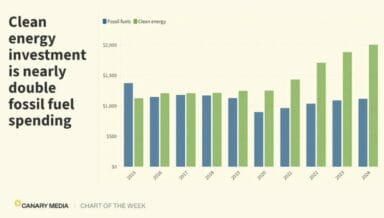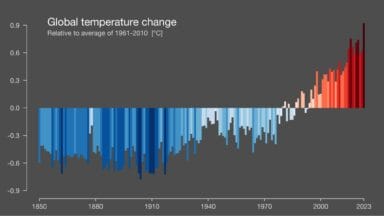
Why Don’t More Voters Care About Climate Change?
Even as deadly heat has scorched much of North and Central America this month, new polling data finds that climate change is still not a top issue for most voters. It’s important for journalists to understand why that is — and to look at their own obligation to help the public understand the monumental climate stakes of the 2024 elections.
The survey results, released by the climate change communications programs at Yale and George Mason universities last week, show that climate ranks 19th among the 28 issues that registered voters prioritize ahead of the November elections. Only President Joe Biden’s political base — liberal Democrats, who comprise roughly one-quarter of the electorate — ranked climate change among their top four issues (along with protecting democracy, abortion, and health care).
There’s a lot for journalists to consider in these results. Would climate change be a higher priority for American voters if more of them understood its connection to the dangerous heat blasting much of the world? Do voters have a clear enough understanding of how a warming climate affects every aspect of their lives?
The Guardian reported today that scientists at World Weather Attribution have concluded that the heat wave that has killed over a hundred people and withered crops across northern Central America, Mexico, and the southern US was made 35 times more likely by climate change — a ferocious start to what will undoubtedly be a brutal summer. Yet most news coverage continues to ignore the connection between climate change and extreme heat, not to mention the fact that climate change itself is driven by fossil fuel use. A new Media Matters report shows that just 12% of national TV segments aired during the recent heat wave in the southwest US made connections to climate change.
There are important exceptions that deserve praise. Almost half of CBS’s segments included explicit links between heat and climate change, far outstripping its competitors in coverage. The network’s local segments and streaming videos — which also spell out the role fossil fuels play in the heat wave — show just how easy it can be to make climate connections for audiences. (For more examples of how to make the climate connection, check out CCNow’s recent extreme heat reporting guidance.)
Those connections are key to helping voters grasp the stakes of November’s elections. “The more people understand climate change’s ‘here, now, us’ realities,” Ed Maibach, a professor at George Mason and director of the university’s Center for Climate Change Communication, told Covering Climate Now, “the more they support ambitious climate policies and candidates who will propose such policies.”
From Us
Local journalists. CCNow just launched Locally Sourced, a biweekly newsletter for reporters working on local angles of the climate story. The first one is focused on extreme heat and includes story ideas and resources, plus reporting tips from NBC Miami’s meteorologist and climate change reporter Steve MacLaughlin. Sign up for Locally Sourced.
En español. See the Spanish-language version of Climate Change Reporting 101, a new CCNow resource designed to help journalists across beats get up to speed on climate change and integrate it into their reporting. Check it out and share it with your newsroom or journalist friends.
Disinfo webinar. Watch a video and read the transcript from our webinar this week on how journalists can strengthen their climate reporting against claims of disinformation and censorship. The panelists were Kendra Pierre-Louis, Climate Reporter for Bloomberg; Marco Silva, Senior Journalist, Climate Disinformation for BBC News; and Wudan Yan, freelance journalist, fact-checker, and entrepreneur. Amy Westervelt, Executive Editor of Drilled, moderated. Take me there.
Noteworthy Stories

Chart courtesy of Canary Media
Progress. About $2 trillion will be invested in clean energy this year, nearly double the amount spent on fossil fuels, according to a new International Energy Agency report. Most of the clean energy investment is happening in the US, the EU, and China, and more spending is needed in developing countries for the world to reach its climate goals. By Carrie Klein at Canary Media…
Isn’t it ironic? Most of the funding from the Biden administration’s climate law, which Republicans in Congress unanimously voted against, is going to Republican congressional districts. More than three-quarters of the $346-billion-worth of announced investments in clean energy projects have flowed into these districts, leading some GOP lawmakers to warm to the law. By Ella Nilsen and Renée Rigdon for CNN…
Power crisis. Residents of Puerto Rico haven’t had reliable electricity since Hurricane Maria ravaged the US territory in 2017, leading to an 11-month blackout. The private utility LUMA Energy, which charges Puerto Ricans some of the highest electricity rates in the entire US, is increasingly leaving people without electricity as they face brutal heat. By Alexander C. Kaufman at HuffPost…
Bonn impasse. Following preparatory talks in Bonn, Germany, for this year’s UN climate summit, COP29, countries were divided on a new climate funding target aimed at helping developing nations combat climate change. Nearly 200 countries will meet in November and are expected to agree on new financing commitments. By Matteo Civillini and Joe Lo at Climate Home News…
Olympic heat. Extreme heat poses health risks at the upcoming Paris Olympics, according to a new report by the British Association for Sustainable Sport and Frontrunners, with input from athletes and scientists. The report warns that “the threat of a devastating hot spell is a very real one” at the games, which kick off next month. By Rutvick Mehta for The Hindustan Times…
Via Social
When reporting on extreme heat, it’s important and accurate to select photos that reflect the severity of the problem. Avoid photos that trivialize the heat, such as kids playing in a pool, and instead use imagery that shows people struggling with high temperatures. In this Twitter thread, CCNow shares suitable photos.
Extreme heat kills more people in the US than hurricanes, floods, and tornadoes combined.
But you wouldn’t necessarily know that from some of the photos often accompanying articles about dangerous heatwaves. pic.twitter.com/AfAhYjsdWf
— Covering Climate Now (@CoveringClimate) June 18, 2024
Ask David: CCNow’s Resident Meteorologist Unpacks Heat Domes
What’s a heat dome, and what does it have to do with climate change? David Dickson, meteorologist and CCNow’s TV engagement coordinator, explains:
Have a climate question for David? Email us at local[at]coveringclimatenow[dot]org.
Industry News
Climate connection commitment. Earlier this month, 44 Japanese weathercasters and meteorologists — some from Japan’s largest TV networks — issued a joint statement pledging to help improve the public’s understanding of the climate crisis. Their statement read, in part: “We will …communicate the connection, whenever there is a connection, between extreme weather and climate change.’”
CCNow applauds this declaration by our colleagues in Japan. Is your newsroom committed to making the climate connection when reporting on extreme weather? Email CCNow, editors[at]coveringclimatenow[dot]org, to discuss how to tackle this crucial aspect of climate reporting.
Extreme weather. Sammy Roth, a climate columnist at the Los Angeles Times, recently talked to the Columbia Journalism Review about his beat, and advised journalists to explain that human-caused climate change is largely the result of fossil fuel emissions, which is leading extreme weather to worsen. “You don’t need to be an expert in climate science to tell people that,” he says. “You can write a sentence or two — and you should write that sentence — making that connection.”
- Feel free to use this concise, scientifically vetted language in your copy to make the connection for audiences: Climate change is mostly caused by burning fossil fuels such as oil, gas, and coal, which releases greenhouse gases into the atmosphere, warming Earth.
Resources & Events

Source: Professor Ed Hawkins (University of Reading) via Show Your Stripes
Climate cohesion. Friday, June 21, is the seventh annual Show Your Stripes Day, which is dedicated to sharing concerns about climate change and the need for solutions. In the US, a number of landmarks will light up tonight, June 20, in support of Show Stripes Day in states including Louisiana, Pennsylvania, and Texas.
Food and farming. Civil Eats has an email-based course, “Climate Solutions in Food & Farming,” available for a small fee, to start any time in June. Learn more.
US elections. The Reuters Institute for the Study of Journalism is holding a webinar, “The great American vote: Insights into the US elections from Politico,” with Alex Burns, head of news at Politico. June 26. RSVP.
US wildfire smoke. SciLine is making Dr. Tracey Holloway, professor of energy analysis and policy at the University of Wisconsin, Madison, available for interviews on US wildfire season and outdoor air quality. June 27. Request an interview.
Clean energy. As part of a series covering key election issues, SciLine is holding a webinar, “Climate change and the green energy transition,” on July 9. RSVP here.
Climate action plans. For US reporters, Evergreen Action and Rocky Mountain Institute have a new spreadsheet with each state’s Priority Climate Action Plan that they submitted to the Environmental Protection Agency. Thanks to Heatmap News’ Emily Pontecorvo for sharing this resource via Twitter.
Jobs, Etc.
Jobs. The Committee to Protect Journalists is recruiting an audience engagement associate (New York, N.Y.). The Guardian US is looking for an editorial visuals designer (New York, N.Y.). The New Bedford Light is hiring an executive editor (New Bedford, Mass.). S&P Global is recruiting a reporter, renewable energy and climate (Washington, D.C., Houston, Texas).
Fellowships. Earth Journalism Network is accepting applications from reporters interested in attending and covering the UN Convention on Biological Diversity in October and November 2024. Apply by July 6.
Awards. The European Journalism Centre, in partnership with the Google News Initiative, is accepting entries for its Climate Journalism Awards. Apply by July 5.
Climate solutions. Solutions Journalism Network is accepting applications to its Climate Peer Network, an open space for journalists to discuss challenges and opportunities and share best practices on climate solutions journalism.
EIN Presswire does not exercise editorial control over third-party content provided, uploaded, published, or distributed by users of EIN Presswire. We are a distributor, not a publisher, of 3rd party content. Such content may contain the views, opinions, statements, offers, and other material of the respective users, suppliers, participants, or authors.

